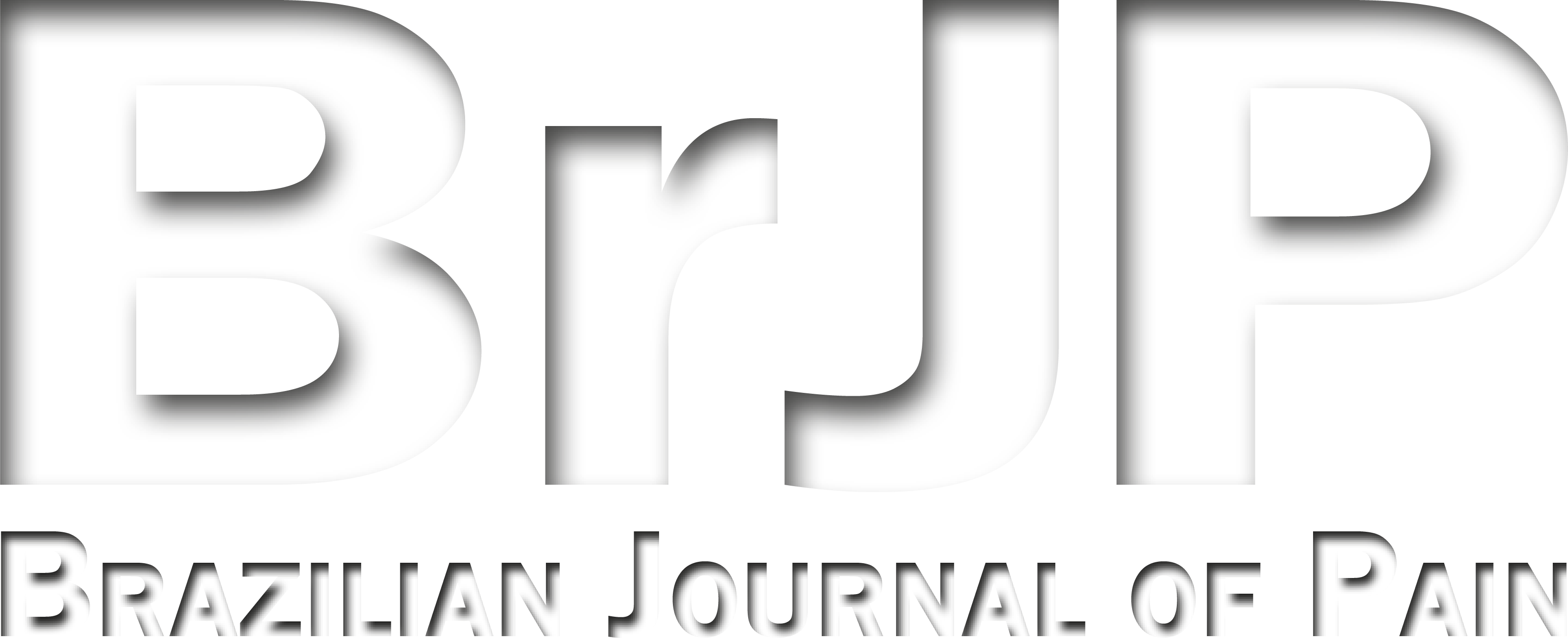Evaluation and physiotherapeutic management of the greater major trochanteric pain syndrome: integrative review
Avaliação e manejo fisioterapêutico na síndrome da dor trocantérica maior: revisão integrativa
Kamilla Maria Sousa de Castro; Erislane Natália de Oliveira Silva
Abstract
Keywords
Resumo
Palavras-chave
References
Mellor R, Bennell K, Grimaldi A, Nicolson P, Kasza J, Hodges P. Education plus exercise versus corticosteroid injection use versus a wait and see approach on global outcome and pain from gluteal tendinopathy: prospective, single blinded, randomized clinical trial. BMJ. 2018;2(361):k662.
Nurkovic J, Jovasevic L, Konicanin A, Bajin Z, Ilic KP, Grbovic V. Treatment of trochanteric bursitis: our experience. J Phys Ther Sci. 2016;28(7):2078-81.
Habib G, Elias S, Abu-Elhaija M, Sakas F, Khazin F, Artul S. The effect of local injection of methylprednisolone acetate on the hypothalamic-pituitary-adrenal axis among patients with greater trochanteric pain syndrome. Clin Rheumatol. 2017;36(4):959-63.
Seo KH, Lee JY, Yoon K, Do JG, Park HJ, Lee SY. Long-term outcome of low-energy extracorporeal shockwave therapy on gluteal tendinopathy documented by magnetic resonance imaging. PLoS One. 2018;13(17).
Allison K, Vicenzino B, Wrigley TV, Grimaldi A, Hodges PW, Bennell KL. Hip abductor muscle weakness in individuals with gluteal tendinopathy. Med Sci Sports Exerc. 2016;48(3):346-52.
Ganderton C, Semciw A, Cook J, Pizzari T. Does menopausal hormone therapy (MHT), exercise or a combination of both, improve pain and function in post-menopausal women with greater trochanteric pain syndrome (GTPS): A randomised controlled trial. BMC Womens Health. 2016;16:32.
Fearon AM, Cook JL, Scarvell JM, NeemanT. Cormick W, Smith PN. Greater trochanteric pain syndrome negatively affects work, physical activity and quality of life: a case control study. J Arthroplasty. 2014;29(2):383-6.
Grimaldi A, Mellor R, Hodges P, Bennell K, Wajswelner H, Vicenzino B. Gluteal tendinopathy: a review of mechanisms, assessment and management. Sports Med. 2015;45(8):1107-19.
Ganderton C, Semciw A, Cook J, Moreira E, Pizzari T. Gluteal loading versus sham exercises to improve pain and dysfunction in postmenopausal women with greater trochanteric pain syndrome: a randomized controlled trial. J Womens Health. 2018;27(6):815-29.
Grimaldi A, Fearon A. Gluteal tendinopathy: integrating pathomechanics and clinical features in its management. J Orthop Sports PhysTher. 2015;45(11):910-22.
Mellor R, Grimaldi A, Wajswelner H, Hodges P, Abbott JH, Bennell K. Exercise and load modification versus corticosteroid injection versus 'wait and See' for persistent gluteus medius/minimus tendinopathy (the LEAP trial): a protocol for a randomized clinical trial. BMC Musculoskelet Disord. 2016;17:196.
Mulligan EP, Middleton EF, Brunette M. Evaluation and management of greater trochanter pain syndrome. PhysTher Sport. 2015;16(3):205-14.
Reid D. The management of greater trochanteric pain syndrome: a systematic literature review. J Orthop. 2016;13(1):15-28.
Schwartsmannr CR, Loss F, de Freitas Spinelli L, Furian R, Silva MF, Zanatta JM. Associação entre bursite trocantérica, osteoartrose e artroplastia total do quadril. Rev Bras Ortop. 2014;49(3):267-70.
Ganderton C, Semciw A, Cook J, Pizzari T. Demystifying the clinical diagnosis of greater trochanteric pain syndrome in women. J Womens Health. 2017;26(6):633-43.
Lin CY, Fredericson M. Greater trochanteric pain syndrome: an update on diagnosis and management. Curr Phys Med Rehabil Rep. 2015;3:60-6.
Whittemore R, Knafl K. The integrative review: updated methodology. J Adv Nurs. 2005;52(5):546-53.
Hopia H, Latvala E, Liimatainen L. Reviewing the methodology of an integrative review. Scand J Caring Sci. 2016;30(4):662-9.
Cook CE, Hegedus EJ. Orthopedic physical examination tests: an evidence-based approach. 2013.
Hirschmann A, Falkowski AL, Kovacs B. Greater trochanteric pain syndrome: abductors, external rotators. Semin Musculoskelet Radiol. 2017;21(5):539-46.
Grimaldi A. Conservative management of lateral hip pain: the future holds promise. Br J Sports Med. 2017;51(2):72-3.
Speers CJ, Bhogal GS. Greater trochanteric pain syndrome: a review of diagnosis and management in general practice. Br J Gen Pract. 2017;67(663):479-80.
Park KD, Lee WY, Lee J, Park MH, Ahn JK, Park Y. Factors associated with the outcome of ultrasound-guided trochanteric bursa injection in greater trochanteric pain syndrome: a retrospective cohort study. Pain Physician. 2016;19(4):547-57.
Vicenzino B. Tendinopathy: Evidence-informed physical therapy clinical reasoning. J Orthop Sports PhysTher. 2015;45(11):816-8.
Torres A, Fernández-Fairen M, Sueiro-Fernández J. Greater trochanteric pain syndrome and gluteus medius and minimus tendinosis: nonsurgical treatment. Pain Manag. 2018;8(1):45-55.
Fitzpatrick J, Bulsara MK, O'Donnel J, McCrory PR, Zheng MH. The effectiveness of platelet-rich plasma injections in gluteal tendinopathy: a randomized, double-blind controlled trial comparing a single platelet-rich plasma injection with a single corticosteroid. Am J Sports Med. 2018;46(4):933-9.
Chowdhury R, Naaseri S, Lee J, Rajeswaran G. Imaging and management of greater trochanteric pain syndrome. Postgrad Med J. 2014;90(1068):576-81.
Morton S, Chan O, Price J, Pritchard M, Crisp T, Perry JD, Morrissey D. High volume image-guided injections and structured rehabilitation improve greater trochanter pain syndrome in the short and medium term: a combined retrospective and prospective case series. Muscles Ligaments Tendons J. 2015;5(2):73-87.
Redmond JM, Chen AW, Domb BG. Greater trochanteric pain syndrome. J Am Acad Orthop Surg. 2016;24(4):231-40.
French HP, Jong CC, McCallan M. Do features of central sensitisation exist in Greater trochanteric pain syndrome (GTPS): a case control study. Musculoskelet Sci Pract. 2019;43:6-11.
Fearon AM, Ganderton C, Scarvell JM, Smith PN, Neeman T, Nash C, Cook JL. Development and validation of a VISA tendinopathy questionnaire for greater trochanteric pain syndrome, the VISA-G. Man Ther. 2015;20(6):805-13.
Submitted date:
12/06/2019
Accepted date:
03/26/2020


